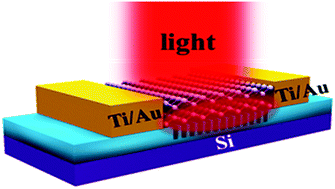Strain engineering coupled with optical regulation towards a high-sensitivity In2S3 photodetector†
Abstract
Non-layered 2D materials exhibit intriguing properties, widening the scope of 2D libraries and promising considerable potential for applications in next-generation optoelectronics. However, due to their surface dangling bonds and weak light adsorption arising from their atomically thin thickness, their photosensitivity is still limited. Herein, we achieve an ultrasensitive 2D In2S3 photodetector by adopting strain engineering coupled with optical regulation. A SiO2 nanograting array was introduced to construct a strained morphology of 2D In2S3. This morphology induces charge localization and renders a back-to-back built-in electric field array, which efficiently suppresses the dark current and separates the photo-excited carriers. Simultaneously, the SiO2 nanograting array realizes light management and improves its light harvesting. As a result, the device presents an ultralow dark current of 3.2 pA with a high signal-to-noise ratio of up to 1.7 × 106. In particular, a prominent photoresponsivity of 1810 A W−1, an excellent detectivity of 2.09 × 1015 Jones and a fast response speed of 0.41 ms are achieved. This work depicts an effective scheme to associate photonic/electronic property manipulation for optoelectronic applications.



 Please wait while we load your content...
Please wait while we load your content...